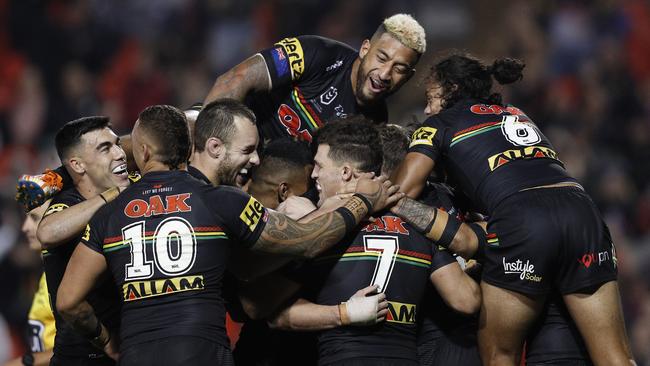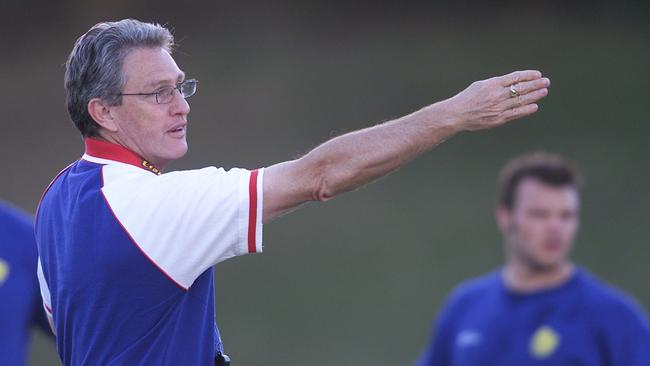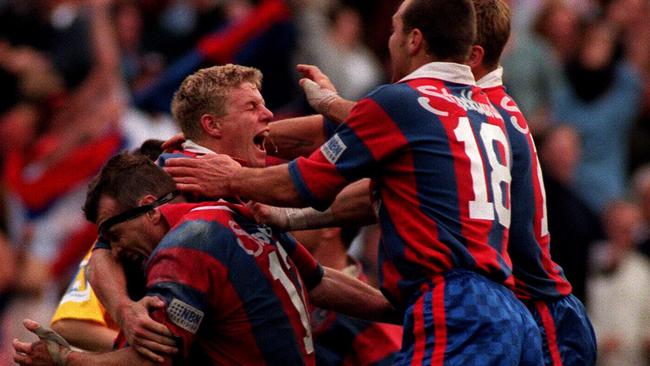Matty Johns: The secret to an NRL club’s success
The best NRL clubs have built their success by getting young talent into their system early and educating them with some basic rugby league principles, writes Matty Johns.

Opinion
Don't miss out on the headlines from Opinion. Followed categories will be added to My News.
It seems that the theme of this season is ‘the haves and the have nots’.
The gap between the best and the rest.
How do you close the gap? Well we can’t, they, the struggling clubs, have to.
Watch The 2021 NRL Telstra Premiership Live & On-Demand with No Ad-Breaks During Play. New to Kayo? Try 14-Days Free Now >
I hear people say the six-again rule and the tempo increase is to blame, but there’s no way we should revert back to a middle-field wrestle fest just to artificially level out the competition.
The game has gone back to what it should be.

There’s a reason why some sides are consistently in the top four, some consistently in the bottom four, and some consistently in between.
Some organisations in the NRL build a club, others just build a team.
To build a successful club takes smart planning, patience, nurturing talent and quality coaching from the top grade down. Any palooka can put a team together, it just takes cash.
Every club has a five-year plan, it’s just that you only hear the losing ones constantly talking about it.
In my rugby league career I was lucky enough to be a part of a club which was built from the bottom up by a group of very smart men.
The Newcastle Knights were to enter the then NSWRL in 1988. Financially they had a shoestring budget, but they had men with plenty of knowledge and plenty of patience.
These men were head coach Allan McMahon, his assistant and rugby league genius Allen Bell, one of the game’s great educators in David Waite, a man who if not going into NRL administration would’ve been a premier coach, in Robert Finch, and one of the game’s best talent identifiers, Keith Onslow.

With little money, these men knew the future of the Knights depended on local talent and rather than try to do it the easy way by identifying 20 or 30 kids and schooling them up to the ways of the Knights, they took on the mammoth task of basically coaching all the kids of the region by hitting all the schools.
I was in year 10 in high school at Maitland when suddenly McMahon, Bell and Waite turned up to run our training session. They did this on numerous occasions, each session brought a new lesson.
LESSON 1 – VOCABULARY
The first step in understanding is vocabulary. They taught us all the names of the Knight’s attacking sequences, the attacking shapes, the clever little ruck plays. There were pops, agains, nexts, double-nexts, pop-agains, Bozo’s, Busts, extras and multiple combinations of these calls.
They taught us how to defend as a collective. The third player from the ruck was the defence decision maker.
If you want to defend in an aggressive outside/in manner, he called Red.
If you found yourself slightly outnumbered he called, Green, which meant the team would revert to a slide defence.
LESSON 2 — SCIENCE
It’s one thing to run a play, it’s another to execute it correctly.
We learnt the subtle nature as ball players of creating a space and how the ball runners would burst into the correct half of the gap made.
As ball players we learnt how to disguise our intention, or as Bell would put it, ‘tell a lie with the football.’

We were taught how to think two plays ahead, how to manipulate a defence in a lead up sequence and leave them short for the next play up our sleeve.
And in the art of organising, they taught us how to divide the field laterally into 10 parts using percentages. For instance, the black dot on the crossbar was the 50 per cent, toward the far touchline 90 per cent, the near goalpost 40 per cent, etc.
LESSON 3 – APPLICATION
Skill, knowledge and the ability to communicate the calls is one thing, pulling all these things together, learning when and how to apply them under pressure and fatigue is what separates the very best. ‘Take two to the 50 per cent for a Billy Bust play’, ‘lay the 40 per cent and come back for a pop-again’, ‘push one more to the 90 per cent and come back with a two pass extra’.
And of course, being able to abandon all these things when the tempo increases and just play fast, reactive football. But then importantly being able to find your way back to the plan is an art in itself, and the domain of the very, very best playmakers.
WHAT THAT YIELDED
For the Knights, out of all that travelling and all the young men they educated, it brought through a core group of local young players who were educated simultaneously, and immediately from day one, had a solid base of understanding.
We played Jersey Flegg together, some under-21s and then ultimately by the time we hit first grade, our instincts were in direct line with how the club wanted to play.
Our understanding was such that we could operate for periods without calls. When a situation occurred, instinctively we knew what had to be done next.
We played by principles, not structure.

You see here’s the thing, it takes years for all this complexity to just become your natural game, to play with total instinct and be exactly in line with the teams principles.
If you look at the best NRL clubs, they have built their success by getting young talent into their system early and educating them simultaneously and then sprinkling that group with a couple of high quality imports.
That was the Knight’s formula. As they entered the competition, their five-year plan was to be a Top 5 finals team, their 10-year plan to win a comp, they achieved both.
I love watching the Penrith Panthers, a perfect example of a group of young men who have come through the same system, playing to the same principles which allows them to play fast and instinctively.
Sam Walker and his family’s decision to have him join the Roosters is genius, he’s a young player who’s been educated incredibly well, coming into a team who have an established, successful style but a side intelligent enough to adjust slightly to suit Sam’s strengths.
Most clubs are operating week to week, year to year. They spend big money on new players and when the team perform badly, they sack the coach and start all over again, and you wonder why the gap is widening.
More Coverage
Originally published as Matty Johns: The secret to an NRL club’s success




